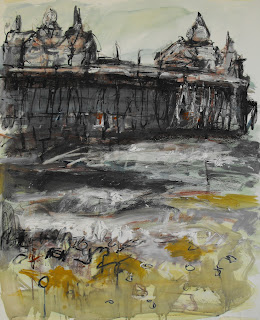I thought I'd mention a really excellent show which I saw recently at the Royal College of Art in London - I don't know if anyone else managed to see it. (It's unfortunately finished now, but I hadn't started the blog last year, so that's why it's only just getting a mention!)
I'm sure you're all familiar with the work of Degas and his Impressionist paintings of young, ballet dancers, women bathing and frisky horses. Certainly, the image used on the poster would lead you to believe that this was going to be a very sickly sweet show all about pastel-coloured young girls in tutus, ending with a nice line in fridge magnets in the gift shop.
However, what this exhibition managed to clearly document (and all kudos to the curators for putting together such a well thought-out and thought-provoking show) was the development of Degas' lifelong obsession with the figure in movement.
Degas was working at a time in the 19th century when there were great technical advances in photography and early film, which were embraced by the artist in the same way that David Hockney is embracing the i-Pad as a tool to make art in his new show at the Royal Academy.
Degas' compositions were pieced together from various studies made from various sources, so that a group of ballet dancers could come from a variety of different studies of individuals or small groups, made in a number of media. The information from all the sources was then jigsawed together to make the final picture, giviing an informed sense of a place and an event, rather than an actual documentation of one specific event - almost like one of his early history paintings.
The pose of the figures would often have a casual, fleeting sense to them, as figures can when caught off-guard by the camera, giving a feeling of capturing a moment in time and a fleeting glimpse of something temporal.
The really exciting thing in the exhibition was the inclusion of his little-seen photographs and their relationship to other work. Here's one of his photos...
Degas, Dancer Adjusting Her Shoulder Strap (Modern gelatin silver print, 1895)
And a pastel and gouache based on the pose - note all the changes made whilst working out the composition, almost as if the figure is blurred in movement, or as if several viewpoints of the same figure were amalgamated into one - which of course, is what Picasso was doing later in 1907 at the birth of cubism.
Another photograph (the intense colour is due to a chemical reaction during development of the plates)...
Degas, Dancer, Arm Outstretched (Collodion on glass, 1895)
And a related pastel with the figure from the photo at the left hand side
So far from being a chocolate-box artist, Degas was instead a modern, radical artist who thought profoundly about visual problems and was fully attuned to the technological developments of his time.
Born in 1834, largely self-taught, this free-thinking and experimental approach paved the way for others in the modern age - look at his incorporation of real objects into his bronze sculpture of the little dancer aged 14, with its ribbon in the hair and tutu made of actual material. That's something everyone from Picasso to Rauschenberg has done.
Again, giving her age of 14 in the title emphasises the temporal movement, and the quick passing of youth.
Increasing blindness forced Degas to give up working in 1912, and for the last 5 years, he was a sad figure shuffling around Montmartre.
One of the most touching things in the exhibition was a short piece of film taken of Degas walking on a street in Paris with his niece. It is strikingly ordinary, with chattering shop-girls on a break at lunchtime walking sassily down the street and playing to the camera. But Degas doesn't notice he's being filmed. It's both ordinary and extraordinary, in that those few seconds capture a fleeting glimpse of one of the true great of art history, just for a moment, not doing anything special, but preserved on a short loop of time. It's strangely appropriate, rather profound, and very touching. It's a work of art in itself.



